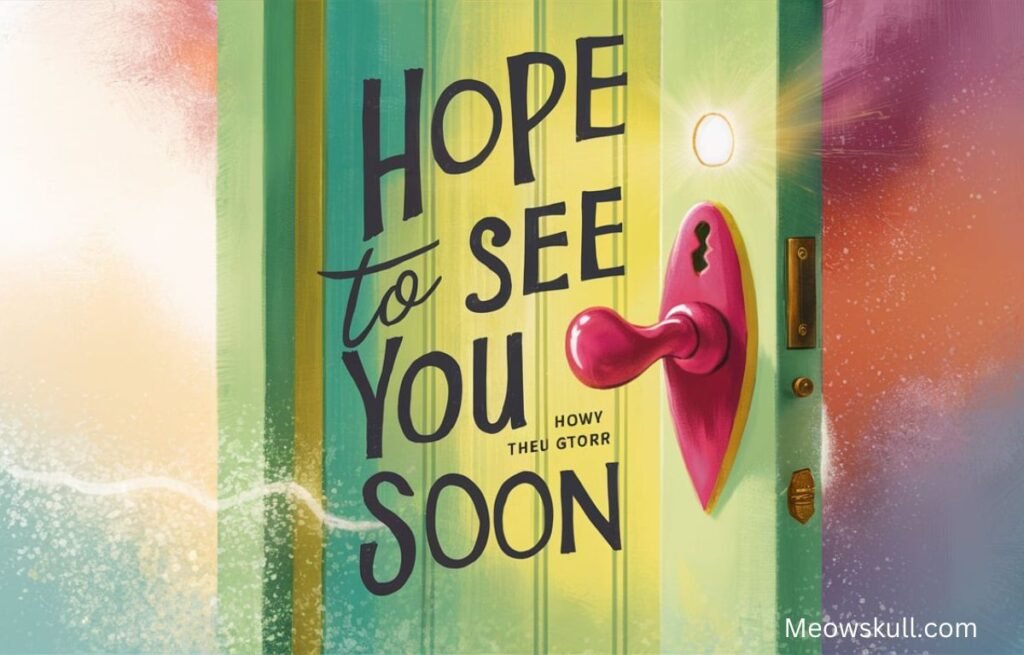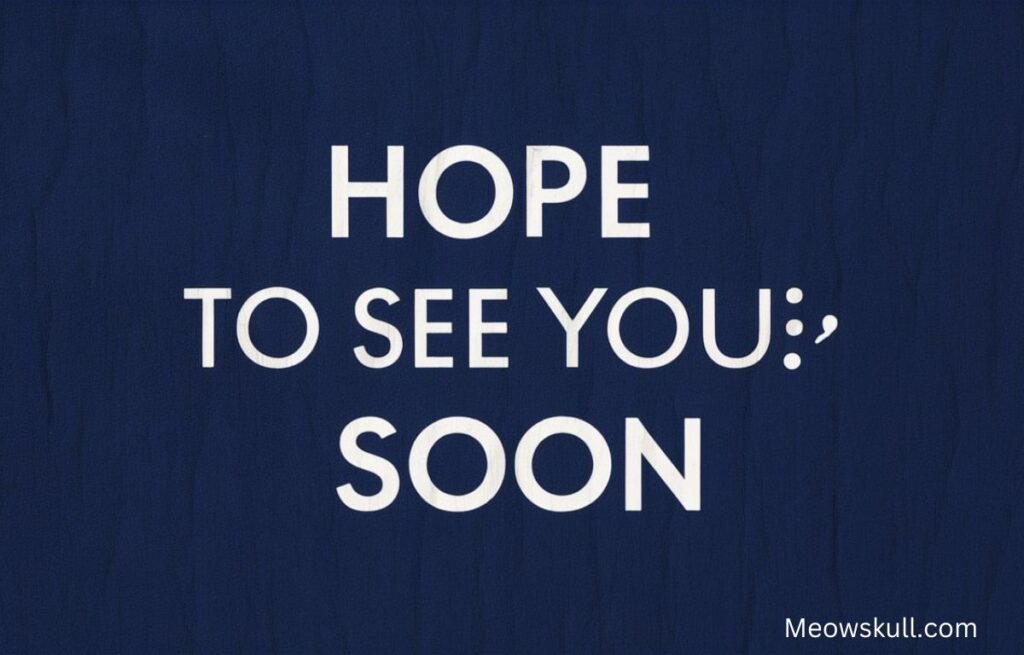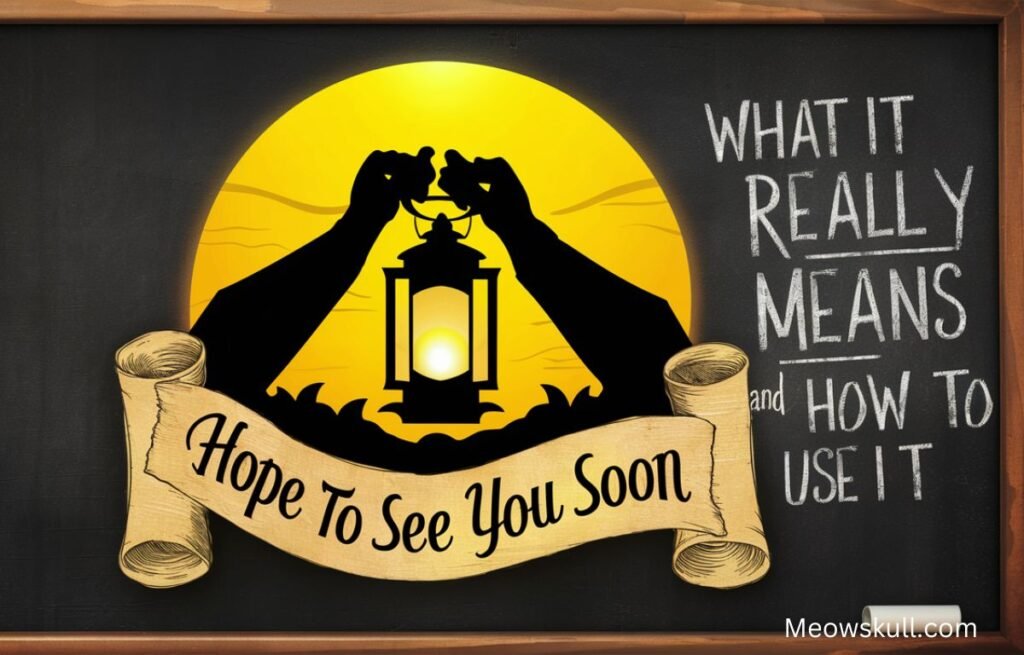In today’s fast-paced world, communication has taken on many forms, from texts and emails to social media posts. Among the various phrases we use, “Hope to see you soon” is a common one, yet it carries more weight than you might think. Whether you’re trying to maintain a personal connection or keep a professional relationship warm, understanding the nuances of this phrase can make all the difference. In this article, we’ll explore what “Hope to see you soon” really means, how to use it effectively, and why it’s more than just a casual goodbye.
What Does “Hope to See You Soon” Really Mean?
The phrase “Hope to see you soon” is often used as a friendly farewell or as a way to express a genuine desire to meet someone in the near future. But there’s more to it than meets the eye. This phrase can convey warmth, affection, and even a touch of anticipation. It’s a way of saying, “I enjoyed our time together, and I’m looking forward to our next meeting.”
In different contexts, “Hope to see you soon” can mean different things. In a professional setting, it might be used to maintain a connection with a colleague or client. In a personal context, it could express excitement about seeing a friend or loved one again.
The Emotional Impact of “Hope to See You Soon”

Words have power, and the phrase “Hope to see you soon” can evoke a range of emotions. For the person hearing or reading it, this phrase can create a sense of anticipation and positive expectations. It reassures them that the relationship is valued and that the next meeting is something to look forward to.
Also Read: Halo (2003) game Icons Banners that Shaped Gaming
In some cases, the phrase can even soften the blow of a goodbye, making it less final and more hopeful. Instead of focusing on the separation, it shifts the focus to the future reunion.
Why “Hope to See You Soon” Is More Than Just a Goodbye
At first glance, “Hope to see you soon” might seem like a simple phrase, but it’s much more than a casual farewell. It serves several purposes:
- Maintains Connection: This phrase helps keep the connection alive, whether it’s with a friend, family member, or colleague. It shows that you care enough to look forward to seeing them again.
- Creates Anticipation: By expressing a desire to meet soon, you create a sense of anticipation, which can strengthen the bond between you and the other person.
- Adds a Personal Touch: In professional communications, this phrase can add a personal touch, making your message more warm and friendly.
- Eases Separation: Saying goodbye can be hard, but “Hope to see you soon” makes it easier by focusing on the future rather than the present parting.
Using “Hope to See You Soon” in Different Contexts

The beauty of “Hope to see you soon” lies in its versatility. It can be used in a variety of contexts, each with its own subtleties. Let’s explore how to use this phrase effectively in different scenarios.
In Personal Relationships
When used in personal relationships, “Hope to see you soon” is often a way to express genuine affection and eagerness to spend more time together. For example, after a pleasant outing with a friend, you might say, “I had a great time today. Hope to see you soon!” This conveys that you enjoyed the time spent together and are looking forward to more.
In a romantic relationship, this phrase can take on an even deeper meaning. It might be used to express the longing to be with someone you care about, especially if you’re in a long-distance relationship. Saying “Hope to see you soon” can reassure your partner that they’re always on your mind and that you’re eagerly awaiting the next time you’ll be together.
In Professional Settings
In a professional context, “Hope to see you soon” can be a powerful tool for maintaining connections and fostering relationships. For instance, after a business meeting, you might use this phrase in an email to express your interest in continuing the conversation or exploring future opportunities.
Here’s an example: “Thank you for the productive meeting today. I look forward to our next discussion and hope to see you soon.” This not only expresses appreciation for the meeting but also signals that you’re interested in future collaboration.
Also Read: The Art of Saying “I Look Forward to Meeting You”
However, it’s important to use this phrase carefully in professional settings. Ensure that it matches the tone of your communication and the nature of your relationship with the recipient. In some cases, a more formal alternative might be appropriate, such as “Looking forward to our next meeting.”
In Social Media and Digital Communication
With the rise of social media and digital communication, “Hope to see you soon” has found its way into texts, tweets, and posts. This phrase can be used to maintain a connection with friends, followers, or colleagues in a light and friendly manner.
For example, after attending a virtual event or catching up with someone via a video call, you might post, “Had a great time at the webinar today! Hope to see you soon, even if it’s just online.” This keeps the connection alive while acknowledging the current circumstances.
Alternatives to “Hope to See You Soon”
While “Hope to see you soon” is a versatile and effective phrase, there are times when you might want to switch it up. Here are some alternatives that convey a similar sentiment:
- Looking forward to seeing you soon: This alternative is slightly more formal and can be used in both personal and professional contexts.
- Can’t wait to see you: This is a more casual and enthusiastic option, perfect for close friends or loved ones.
- Excited to see you soon: This phrase adds a touch of excitement and can be used when you’re genuinely eager to meet someone.
- See you soon: Sometimes, simplicity is key. “See you soon” is straightforward and to the point, but it still carries warmth and positivity.
Each of these alternatives has its own tone and can be chosen based on the context and your relationship with the person.
Common Misunderstandings and Pitfalls

Like any phrase, “Hope to see you soon” can be misunderstood or misused. It’s important to be aware of these potential pitfalls to ensure your message is received as intended.
Overusing the Phrase
While “Hope to see you soon” is a warm and positive phrase, overusing it can dilute its impact. If you use it too often, especially in professional communication, it might come across as insincere or routine. To avoid this, try to use the phrase only when you genuinely mean it and when it’s appropriate for the context.
Misinterpreting the Intent
The intent behind “Hope to see you soon” can sometimes be misinterpreted, especially in written communication where tone and body language are absent. For example, in a professional setting, someone might perceive this phrase as overly familiar or even presumptuous if the relationship isn’t close.
To avoid misunderstandings, consider the nature of your relationship with the person and the context in which you’re using the phrase. If in doubt, opt for a more neutral or formal alternative.
Ignoring Cultural Differences
Cultural differences can also play a role in how “Hope to see you soon” is perceived. In some cultures, this phrase might be seen as too forward or casual, while in others, it might be perfectly acceptable. When communicating with someone from a different cultural background, it’s important to be mindful of these nuances and adjust your language accordingly.
The Power of Follow-Through
One of the most important aspects of using “Hope to see you soon” is the follow-through. If you express a desire to see someone soon, it’s important to take action to make that happen. This might involve scheduling a meeting, planning a get-together, or simply reaching out to stay in touch.
Also Read: The Power of Raven Team Leadership: A Quick Guide
Following through on your words shows that you mean what you say and that you value the relationship. It also strengthens the connection and builds trust, whether in a personal or professional context.
Conclusion: The Lasting Impact of “Hope to See You Soon”
In a world where connections are often fleeting, the phrase “Hope to see you soon” carries significant weight. It’s more than just a casual goodbye; it’s a way of expressing warmth, maintaining relationships, and creating anticipation for the future.
By understanding the nuances of this phrase and using it thoughtfully, you can strengthen your connections, whether in your personal life or professional endeavors. Remember, it’s not just the words you use but the intent and follow-through that make all the difference.
So next time you say “Hope to see you soon,” know that you’re doing more than just saying goodbye—you’re laying the foundation for a future filled with meaningful connections.
FAQs
What Does “Hope to See You Soon” Mean?
“Hope to see you soon” is a phrase used to express a desire to meet someone again in the near future. It’s often used as a friendly farewell or a way to maintain a connection with someone, whether in a personal or professional context.
Can “Hope to See You Soon” Be Used in Professional Settings?
Yes, “Hope to see you soon” can be used in professional settings, but it’s important to consider the tone and nature of the relationship. It can add a personal touch to your communication, but should be used appropriately to avoid coming across as too familiar.
What Are Some Alternatives to “Hope to See You Soon”?
Some alternatives to “Hope to see you soon” include “Looking forward to seeing you soon,” “Can’t wait to see you,” “Excited to see you soon,” and simply “See you soon.” Each alternative can be chosen based on the context and the level of formality required.
Is “Hope to See You Soon” Appropriate for Social Media?
Yes, “Hope to see you soon” is appropriate for social media, especially when you want to keep a connection alive with friends, followers, or colleagues. It can be used in posts, comments, or messages to maintain a friendly tone.
How Can I Avoid Overusing “Hope to See You Soon”?
To avoid overusing “Hope to see you soon,” try to reserve it for situations where you genuinely mean it and where it’s contextually appropriate. Using it too often, especially in professional communication, can make it seem insincere.
Can “Hope to See You Soon” Be Misunderstood?
Yes, “Hope to see you soon” can be misunderstood, particularly in written communication where tone isn’t clear. To avoid misinterpretation, consider the relationship and context, and choose a more neutral or formal alternative if necessary.
What Should I Do After Saying “Hope to See You Soon”?
After saying “Hope to see you soon,” it’s important to follow through. Whether it’s scheduling a meeting or simply reaching out later, taking action shows that you value the relationship and that your words were sincere.
Are There Cultural Differences in Using “Hope to See You Soon”?
Yes, cultural differences can affect how “Hope to see you soon” is perceived. In some cultures, it might be seen as too casual or forward. It’s important to be mindful of these differences and adjust your language accordingly.
Is “Hope to See You Soon” the Same as “Goodbye”?
No, “Hope to see you soon” is not the same as “Goodbye.” While “Goodbye” is more final, “Hope to see you soon” focuses on the future and expresses a desire to meet again, making it a more hopeful and positive way to part.
When Should I Use “Hope to See You Soon”?
You should use “Hope to see you soon” when you want to express a genuine desire to meet someone again in the near future. It’s appropriate for farewells in personal, professional, and digital communication, as long as it’s used thoughtfully.

As a seasoned contributor to “Meowskull”, Rosalie combines her linguistic prowess with a keen understanding of various topics, ensuring a delightful and informative reading experience. Her articles effortlessly blend clarity, creativity, and a touch of elegance, making language exploration an exciting journey for readers.